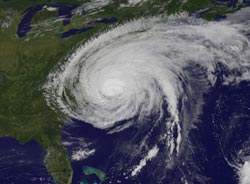Paleotempestology and 2011's Hurricane Irene

Hurricane Irene makes landfall in Onslow Bay, North Carolina, 27 Aug. 2011. Image courtesy NASA.
Hurricane Irene made landfall in Onslow Bay, North Carolina, USA, on 27 August 2011, at which time it had been downgraded to a Category 1 hurricane after hitting the Bahamas at Category 3 strength.
In their GSA Today article, geoscientists Scott P. Hippensteel, Matthew D. Eastin, and William J. Garcia of the University of North Carolina at Charlotte call for a better understanding of the long-term record of storm frequency and impact, not only because of the increase in the strength of storms hitting coastal areas but also because of the high population density in vulnerable areas along the U.S. East Coast and Gulf Coast.
Those who study the paleo-storm record explain that gaining understanding of past events provides the context for future coastal vulnerability. Hippensteel and colleagues apply evidence of what they call the “lack of a definitive signature” from Hurricane Irene to a 1500-year paleostorm record at Onslow Bay. They write that fewer hurricanes could be found in the fossil and sedimentary records (through bioturbation or foraminiferal dissolution) than had actually made landfall there.
The authors infer that the lack of storm records in the marsh sediments from Onslow Bay means that only hurricane strikes of higher magnitude can provide proxies for understanding the paleostorm record, because only the most robust storm deposits are archived. The lack of definitive signs of Hurricane Irene in the area raises their concerns about the current understanding of hurricane deposition and preservation.
ARTICLE
The geologic legacy of Hurricane Irene: Implications for the fidelity of the paleo-storm record
Scott Hippensteel et al., Dept. of Geography and Earth Sciences, University of North Carolina at Charlotte, Charlotte, North Carolina 28223, USA; shippens@uncc.edu. Pages 4–10; doi: 10.1130/GSATG184A.1, http://www.geosociety.org/gsatoday/.
GSA Today articles are posted online; for a print copy, please contact Kea Giles. Please discuss articles of interest with the authors before publishing stories on their work, and please make reference to GSA Today in articles published.
Contact:
Kea Giles
Managing Editor,
GSA Communications
+1-303-357-1057
kgiles@geosociety.org
Media Contact
More Information:
http://www.geosociety.orgAll latest news from the category: Studies and Analyses
innovations-report maintains a wealth of in-depth studies and analyses from a variety of subject areas including business and finance, medicine and pharmacology, ecology and the environment, energy, communications and media, transportation, work, family and leisure.
Newest articles

A universal framework for spatial biology
SpatialData is a freely accessible tool to unify and integrate data from different omics technologies accounting for spatial information, which can provide holistic insights into health and disease. Biological processes…

How complex biological processes arise
A $20 million grant from the U.S. National Science Foundation (NSF) will support the establishment and operation of the National Synthesis Center for Emergence in the Molecular and Cellular Sciences (NCEMS) at…

Airborne single-photon lidar system achieves high-resolution 3D imaging
Compact, low-power system opens doors for photon-efficient drone and satellite-based environmental monitoring and mapping. Researchers have developed a compact and lightweight single-photon airborne lidar system that can acquire high-resolution 3D…





















